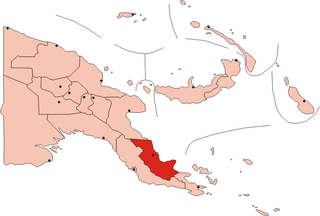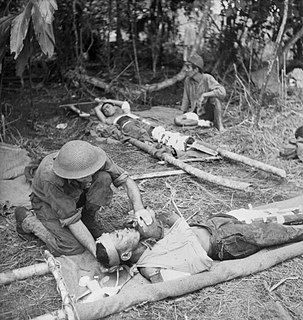Related Research Articles
Maroubra Force was the name given to the ad hoc Australian infantry force that defended Port Moresby, Papua New Guinea from the Japanese, and was involved in the Kokoda Track Campaign of the Pacific War, World War II. The force was established by the Allies under the codename "Maroubra", referring to the troops in the forward area, it was one of many units forming the body of the New Guinea Force, the main Allied army formation in the South West Pacific Area during 1942.

The 3rd Battalion was an infantry battalion of the Australian Army. Originally raised as part of the First Australian Imperial Force for service during World War I, the battalion formed part of the 1st Brigade, attached to the 1st Division. It was formed shortly after the war broke out and was among the first Australian units to be sent overseas, arriving in Egypt in December 1914. In April 1915 the battalion participated in the Landing at Anzac Cove, coming ashore in the second and third waves. In December 1915 the 3rd Battalion was evacuated from the Gallipoli peninsula and withdrawn to Egypt again, where it took part in the defence of the Suez Canal before being sent to France to fight on the Western Front in March 1916. For the next two and a half years the unit would serve in the trenches in France and Belgium and would take part in many of the major battles fought during that time. In May 1919, following the end of the war, the battalion was disbanded and its personnel repatriated back to Australia.

Tomitarō Horii was a lieutenant general in the Imperial Japanese Army during World War II. After graduating from the Imperial Japanese Army Academy in 1911, Horii served in China before undertaking a variety of regimental appointments. Following Japan's entry into World War II, he commanded a division during the capture of Guam before commanding the Japanese force that had been given the task of capturing Port Moresby. In November 1942, in the retreat from Oivi–Gorari, Horii drowned while attempting to canoe down the Kumusi River to reach Japanese forces defending Buna–Gona. His canoe was swept out to sea and capsized.

Oro Bay is a bay in Oro Province, Papua New Guinea, located 15 miles (24 km) southeast of Buna. The bay is located within the larger Dyke Ackland Bay. A port is operated by PNG Ports Corporation Limited with limited wharf facilities, located at 8°53′47″S148°29′39″E.

The '5th Division' was an infantry division of the Imperial Japanese Army. Its call sign was the Koi (Carp) Division. The 5th Division was formed in Hiroshima in January 1871 as the Hiroshima Garrison, one of six regional commands created in the fledgling Imperial Japanese Army. Its personnel were drafted from Hiroshima, Yamaguchi and Shimane.

The 2/6th Armoured Regiment was an armoured regiment of the Australian Army that served during World War II. Raised in 1941 the Regiment took part in the Battle of Buna–Gona in 1942–43, however, it did not see further action during the war and was disbanded in September 1945.
Wanigela is a village along Collingwood Bay, Papua New Guinea. The village is served by Wanigela Airport.
The Kapa Kapa Trail is a steep, little-used mountain trail that stretches from the Kapa Kapa village on the south coast of Papua New Guinea, across the extremely rugged Owen Stanley Range, to the vicinity of Jaure on the north side of the Peninsula. Also known as the Kapa Kapa-Jaure Track, the trail runs parallel to but 48 kilometres (30 mi) southeast of the better-known and more accessible 96-kilometre-long (60 mi) Kokoda Track. The 210-kilometre-long (130 mi) Kapa Kapa Track is more than twice as long as the Kokoda Track and at its highest point, 10,100 feet (3,100 m), is more than 1,000 metres (3,300 ft) higher. Total ascent and descent is around 14,400 metres (47,200 ft). Because the track is very steep, difficult, and unimproved, it has been hiked by very few non-native individuals.

The 2nd Battalion, 127th Infantry Regiment traces its origins to the 4th Infantry Battalion, Wisconsin National Guard.
Soputa is a village located inland from Gona, Buna and Sanananda in Oro province, Papua New Guinea. The village is located at the crossroads of the Kokoda-Sananada Road and Buna-Kokoda Road. Trails lead to Buna and Sananada.
Gona is a coastal village in Oro Province, Papua New Guinea.
Sanananda is a village on the coast of Oro Province, Papua New Guinea.

The Invasion of Buna–Gona, called Operation RI by the Japanese, was a military operation by Imperial Japanese forces to occupy the Buna–Gona area in the Territory of Papua during the Pacific campaign of the Second World War. The initial landings and advance on Kokoda occurred between 21 and 27 July 1942. The Japanese invaded and occupied the location in preparation for an overland attack on Port Moresby along the Kokoda Track. The landing marked the start of the Kokoda Track campaign. The landings were not directly opposed by land forces but were engaged by elements of Maroubra Force as they advanced on Kokoda. This initially included B Company of the 39th Battalion, patrols of the Papuan Infantry Battalion (PIB) operating in the area and a small number of the Australian New Guinea Administrative Unit (ANGAU) that became attached to the force. The Australians were initially repulsed near Oivi but subsequently regrouped to defend Kokoda in an initial battle there from 28–29 July.

The 144th Infantry Regiment was an infantry regiment in the Imperial Japanese Army. The regiment was attached to the 55th Division. The regiment participated in the Second Sino-Japanese War and World War II, fighting in the Pacific during a number of battles including those at Guam, Rabaul, and Salamaua. It also participated in the invasion of Buna-Gona, the Kokoda Track campaign and the battle of Buna–Gona.
Lieutenant Colonel Gordon Grimsley King, DSO was an officer of the Australian Army during the Second World War.

The Battle of Buna–Gona was part of the New Guinea campaign in the Pacific Theatre during World War II. It followed the conclusion of the Kokoda Track campaign and lasted from 16 November 1942 until 22 January 1943. The battle was fought by Australian and United States forces against the Japanese beachheads at Buna, Sanananda and Gona. From these, the Japanese had launched an overland attack on Port Moresby. In light of developments in the Solomon Islands campaign, Japanese forces approaching Port Moresby were ordered to withdraw to and secure these bases on the northern coast. Australian forces maintained contact as the Japanese conducted a well-ordered rearguard action. The Allied objective was to eject the Japanese forces from these positions and deny them their further use. The Japanese forces were skillful, well prepared and resolute in their defence. They had developed a strong network of well-concealed defences.
The 229th Infantry Regiment was an infantry regiment in the Imperial Japanese Army. The 229th consisted of conscripts drawn mainly from Gifu Prefecture. The regiment was attached to the 38th Division. The regiment participated during the Second Sino-Japanese War, the conquest of Hong Kong in 1941, the Dutch East Indies in early 1942, the Guadalcanal Campaign and Papua Campaign. While the 1st and 2nd Battalions were on Guadalcanal, its 3rd Battalion fought in the Battle of Buna–Gona in Territory of Papua from November 1942 to January 1943, where it was destroyed. The regiment was re-formed and later fought during the New Georgia campaign where the regiment was commanded by Colonel Hirata Genjiro, while the 1st Battalion was commanded by Major Hara Masauo while Major Kojima Bunzo commanded the 3rd Battalion.

The Battle of Buna–Gona was part of the New Guinea campaign in the Pacific Theatre during World War II. It followed the conclusion of the Kokoda Track campaign and lasted from 16 November 1942 until 22 January 1943. The battle was conducted by Australian and United States forces against the Japanese beachheads at Buna, Sanananda and Gona. The Allied advance on the Japanese positions at Buna–Gona was made by the 16th and 25th Brigades of the Australian 7th Division and the 126th and 128th Infantry Regiments of the US 32nd Infantry Division. During the course of the battle, a further four infantry brigades, two infantry regiments and an armoured squadron of 19 M3 Stuart tanks were deployed.

The Battle of Buna–Gona was part of the New Guinea campaign in the Pacific Theatre during World War II. It followed the conclusion of the Kokoda Track campaign and lasted from 16 November 1942 until 22 January 1943. The battle was conducted by Australian and United States forces against the Japanese beachheads at Buna, Sanananda and Gona.
The 21st Independent Mixed Brigade was an infantry brigade of the Imperial Japanese Army raised during World War II. Formed in January 1941 in Osaka, Japan, the brigade consisted of a single infantry regiment and support elements. It undertook occupation duties in Indochina before being sent to Malaya and then Rabaul. In late 1942, the brigade was sent to take part in the Battle of Buna–Gona in New Guinea. It was withdrawn to Rabaul, and then Japan, in June 1943. Elements of the brigade were converted into other formations and the formation ceased to exist in July 1943.
References
Coordinates: 9°04′S148°34′E / 9.067°S 148.567°E
| | This Oro Province geography article is a stub. You can help Wikipedia by expanding it. |